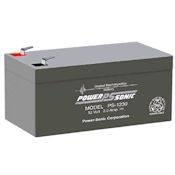
A battery is an electrochemical device, using chemical reactions between two different substances to create electric current. Basic battery design calls for two electrodes: an anode (negative terminal) and a cathode (positive terminal). These are never allowed to have direct contact, since that would create a short circuit. They are instead connected indirectly by an electrolyte. Using the electrolyte as a bridge, the anode and cathode react so that positively charged electrons travel to the cathode and negatively charged electrons travel to the anode. Left alone, this operates as a circuit for electric current. When a device is connected to the battery, it forms a larger circuit, with power flowing out of the cathode and then back into the anode, minus much of the charge.
In a lead-acid battery, the anode and cathode are made of lead and lead dioxide respectively. The electrolyte is a solution made with one-third sulfuric acid. As power is discharged from the battery, both the anode and cathode undergo a chemical reaction that progressively changes them into lead sulfate.
When electric current is applied to a lead-acid battery, the electrochemical reaction is reversed. When current flows into the battery through the anode, it causes the conversion of the anode and cathode into lead sulfate to partially reverse. This partial reversal to their original states "recharges" them.
Lead-acid batteries are a 19th century invention. While they have seen much improvement, they are still relatively primitive. They have extremely poor overall power-to-weight ratio and stamina issues. However, what they can do is deliver a big, sudden charge of electricity. This potential to put out a big jolt of power makes them ideal for use as car batteries, where there is a need for a big, short charge to power the engine's starter.